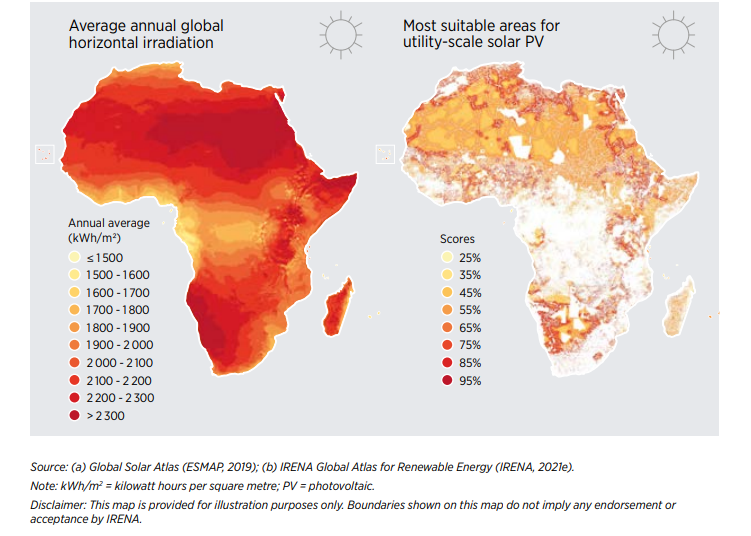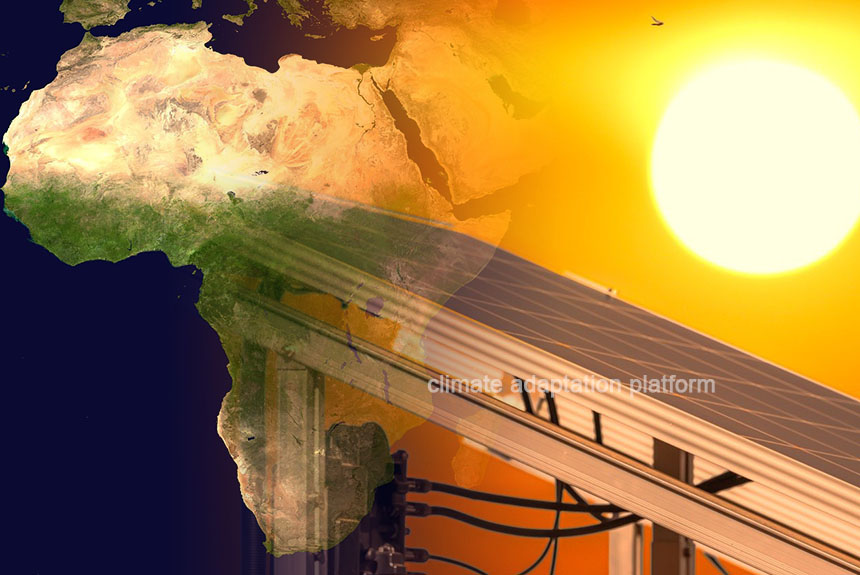Africa is often hailed as the “sun continent” because it enjoys abundant sunshine, with most regions enjoying 300 days of sunlight per year.
According to the International Renewable Energy 2022 Report Agency (IRENA), the continent receives an annual average solar irradiation of 2 119 kilowatt hours per square metre (kWh/m2), with most countries across North, West and Southern Africa receiving an average over 2100 kWh/m2 annually.
IRENA estimates the continent’s solar photovoltaic (PV) technical potential at 7900 GW,3 indicating the vast potential for solar power generation.
The IRENA map below shows Africa’s average annual global horizontal irradiation and the most suitable areas for utility-scale solar PV.

According to the International Energy Agency (IEA), Africa boasts 60% of the world’s best solar resources, yet it only has installed 1% of its solar capacity. Under a Sustainable Africa Scenario (SAS), universal access to affordable electricity can be achieved by 2030. This means big connections to 90 million people yearly, three times more than the recent connection rate.
Currently, 43% of the population, or 600 million people, lack access to electricity. Most of them live in sub-Saharan Africa. The report’s analysis shows that extending national grids is the least costly solution for almost 45% of those gaining access by 2030. In rural areas, where 80% lack electricity access, solar-based mini-grids and stand-alone system electricity are the most feasible solutions.
WRI reports that Makueni, a county in Kenya, launched an Energy Plan in September 2024. The plan includes installing a new solar PV system at the county’s biggest rural health facility, generating 288 MWh annually to meet 30-33% of the power-strapped hospital’s electricity needs.
Makueni County Referral Hospital treats approximately 500 patients daily in a region where modern infrastructure can be hard to come by. Electricity in Makueni County is getting expensive, and power outages are common.
Installing additional electricity capacity in the County’s Referral Hospital will allow the government to save some money from their power subsidy while providing the hospital with a clean and more stable power source.
The plan targets several areas where clean energy can be installed and could generate the most optimal benefit to the community, especially to the farmers.
In rural areas, farmers need electricity to power their irrigation systems, which grow their crops, and refrigeration and storage, which increase production.
While Kenya has made some improvements in expanding electricity access to its people, around 12 million Kenyans of its 54.5 million population do not have access to electricity.
In Makueni County, the situation is quite similar. 250,000, or 75% of its population, do not have any form of electricity, and 68 healthcare facilities in the county are still not connected to the grid.
Makueni County’s new energy plan can help boost access to affordable and reliable energy that is crucial in providing quality healthcare and running its life-saving equipment. It also aims to improve agriculture production and the livelihoods of farmers in the County to grow their important crops like mung beans, maize, fruits, vegetables, fish, poultry, and dairy) access to renewable energy would help stimulate energy consumption and economic growth.
Makueni County Energy Plan has benefitted from geospatial technologies, online mapping platforms, and an open-source geospatial electrification toolkit to estimate the technology and investment cost required to meet the plan’s clean energy targets.
The Makueni Energy Plan includes expanding electricity access to more households in Makueni, providing clean energy to the agriculture sector to improve production and livelihoods, powering more hospitals with renewable energy, and expanding electric vehicles. However, funding is needed to achieve all these targets.
Sources:
Renewable Energy Market Analysis. Summary for Policy Makers. (2022). IRENA. Retrieved from https://www.irena.org/-/media/Files/IRENA/Agency/Publication/2022/Jan/IRENA_Market_Africa_2022_Summary.pdf
Africa Energy Outlook 2022. Key Findings. IEA. Retrieved from https://www.iea.org/reports/africa-energy-outlook-2022/key-findings
Ireri, B., Otieno, V., Mentis, D., Ronoh, D., & Ngowa, A. (2024, September 13). One County in Rural Kenya Is Using Clean Energy to Close its Electricity Gap. WRI. Retrieved from https://www.wri.org/insights/makueni-county-kenya-clean-energy-plan?



Leave a Reply